Each gardener and the owner of the household plot seeks to create unique landscape compositions using various flowering plants for this. Most often, flower beds and flower beds are formed from the usual and familiar flowers, such as petunia or lavender. However, if desired, something special and unique can be drawn to the exotion flowers, which appeared in our gardens from distant countries. It is precisely such plants that refers scene, landing and care for which they have their own characteristics, but at a competent approach, each can grow such a wonderful plant on its site.
Few people know that this Australian plant has quite famous theses in ancient times, for example, Guy Muitions of Sutsevan - the Rome young man who gave his right hand for Rome's freedom, or Quint Solezol - Roman lawyer.
In this article, consider the features of the scenes, we give a description of the most popular and common varieties of this plant. We note the important points and rules for landing and care for the scenario in our climatic conditions.
Features and Morphological Description Solesol
The scene is an exotic plant for our latitudes, which in recent years just broke into our gardens and flower beds. It is considered underestimated, since many lovers of blooming plants have never even heard this name and have no idea about such a beautiful and incredibly long-flowered plant, which can be decorating not only flower beds or alpine slides, but also rooms, as well as terraces or balconies.
The scene is a natural perennial or annual grassy flowering plant, which refers to a little-known Gudeni family. The natural area of \u200b\u200bhabitat of this extraordinary plant is the territory of tropical Australia, New Zealand and Western India, where the scene is found on forest edges, slopes and meadows, spreading a beautiful flowering carpet of cold shades. The territory of Russia and European scene was brought about 100 years ago, i.e. In the culture, this flower began to use only the second half of the 18th century. To date, it is known about 12 varieties of scenes, which have different characteristics and features. However, it is possible to grow only in greenhouse conditions or in greenhouses. It is known about one form of a skewer flower, which can be grown on the household plot - it is a scene-like or pleasant.
The scientific name "Scaevus" occurred from the Latin word and denotes the "left", which is associated with the form of a plant of the plant flowers. The scene is pleasant also has a number of popular names that they have appropriated for certain external qualities. The most famous of them are a fairy flower, a flower fan or a propeller. All these names are related primarily with a form of colors that consist of petals located in the form of a fan.
Since this is a tropical flowering plant, it is quite difficult to grow it on its site, which is why most of the gardeners are afraid of possible problems and the beauties of scenes are afraid. However, it is worth putting at least one plant on your flowerbed or in a pot, and you will not stop more, you will always strive to replenish the collection and acquire another variety of Australian beauties.
Description Solesol:
- In nature, the scene flower is a perennial herbaceous plant, however, in the conditions of our moderate cold climate, it is possible to grow it as an annual plant.
- They can grow in the form of grassy plants, as well as shrubs and semi-stares, depending on the specific variety of scenarios.
- These decorative flowering plants in height can grow from 40 cm to 70 cm, so they are easy to use to create a variety of garden compositions.
- The scene is quickly growing, the diameter of one bustle can be approximately 50-60 cm.
- The plant is formed by a large number of subtle upright stroke stems. They have a dark green shade. Since the shoots of this plant falling, then often the scene is agreed in the suspended pots and porridge, which allows you to create beautiful flowering hats in the air. Sobs are very flexible and thick, so it is easy to accept any shape. By the end of the vegetation period, the skewer's bustice takes the right spherical shape.
- On the stems in large quantities, the leaves that can be solid, all-ray or toothed are once or opposed. Most often you can meet a scene with leaves that are very reminded by a dandelion leaves. The sheet plate is thin, bright green with a leathery surface, can reach 9-10 cm in length.
- Flowers at the scenes stuffed, single or less often collected in the top half-blooded inflorescences. Flowers are fruitful, resemble a fan. The whore consists of smooth 5 petals, in the center there are stamens, also in the amount of 5 pieces.
- The scene is characterized by more cold shades of their colors. You can meet the varieties of plants with white flowers, blue, lilac, purple, raspberry shades of petals.
- Flowers scenes are small, in diameter can reach 3 cm. However, during flowering, they are collected on the tops of the color lines of 5-15 pieces and bloom continuously, which is the main feature of this plant.
- The scene blooms all summer, gradually revealing all new buds. One flower on average revealed for about 2 weeks, after which new flowers come to his shift. Therefore, this flower is so appreciated in landscape design for its high decorativeness.
- After the flower breeze, a two-chamber marking with one seed in each chamber is formed on shoots.
- There are skewers and the fruit, which is a berry-like bustle with a very solid bone inside.
Variety of scenes varieties
On the territory of Russia in the conditions of a cold winter can be grown as an annual plant only one kind of scenes - it is a pleasant scene, which is a low tight bush that is forming by falling shoots. In height, this plant can reach about 50 cm. The leaves are oblong with a toothed edge of about 8 cm. Flowers are small, up to 2-2.5 cm in diameter, consist of a tubular cup and 5 petals, which are located in the form of a veser on one side of the tube . The varieties of this species with violet colors are most popular.
Consider the characteristics of the most popular varieties of scenarius pleasant, which can be grown on their plot or in vases:
- Solesol variety a pleasant "Blue Wonder". This is perhaps the most popular variety, which is more often found in our gardens. It is an annual plant that is perfectly suitable as a soil culture. In height can reach 15-20 cm. The bush is formed by lying, slightly raised stems, which are thickly covered with lancet leaves with a toothed edge. Single flowers, small, stubby. Petals are located in the form of a fan, have a purulent blue shade.
- Blue Fan skewers. This variety was also widely distributed in our gardens. It is a low bush up to 45 cm in height, which is formed by falling subtle shoots. The form of the plant is neat, the stems are arranged tightly to each other, so this variety is perfect and as an ampel plant, and as the soil. Flowers are small, fan-shaped, have a lilac shade with a white eye in the center.
- Sutscents of a pleasant alba. A snow-white representative of the scenario is pleasant, which looks very impressive in combination with other blooming plants, as well as in the vases on terraces and balconies. In height, the plant can reach about 35-45 cm. Flowers fan-shaped, collected on the tops of inflorescences of 5-15 pieces, have white.
- Saint stems Saphira. A very beautiful representative of the scene is pleasant. The height of the bus can reach 30 cm, which allows it to spectacularly look in suspended porridges and vases, as well as on the Alpine slides. It has a quick increase, can grow in diameter up to 45 cm. Throughout the summer, flowes sapphire-blue flowers in the form of a fan.
- Variety skewers Topaz Pink. A very bright and spectacular variety, which will be an excellent decoration of any plot and can compete with its beauty even with petunias. The stalks of the plant in height are raised by about 30-35 cm. The flowering of this variety is very abundant and long. Petals in the form of a foore have a beautiful bright pink shade.
- Solesmills of White Laguna. A representative of the species of scenarius is pleasant, is a beautiful soil coasting, which can be at a height of about 45 cm. Food is formed by thin lying and raising shoots with oblong leafy leaves of herbal green. Flowers are assembled on the tops of the flowers and have a snow-white shade.
- Solesol variety a pleasant Blue Laguna. This variety of the Australian flower in height can grow only by 15-25 cm, but the length of the shoots is 45-65 cm, which allows it to grow it on suspended porridge and in floor vases. Blossom begins in early June and lasts until the autumn. Flowers of improper decorative shape in the form of a fan, petals have a gentle lilac color, yellow stamens.
Scenes reproduction: the most common ways
The scene is from nature with a perennial plant, although it is grown in our territory as an annual flower, so two ways are suitable for its dilution at home. This is seed reproduction and vegetative, or rather, the reproduction of stalling. Each method has a number of nuances and rules that it is important to take into account in order to in the end to get a beautiful and healthy flowering plant. Consider in more detail every breeding method.
Seed reproduction of scenaries
- This method of independent breeding scenery is considered more complex and time consuming, since the seeds of the sceners spare at a long time and are not always distinguished by a good germination.
- Seeds of this plant can be purchased in specialized garden centers or assemble independently if there is an adult cochetic combustible combustible curves on your site.
- It is necessary to prepare suitable containers, pots or other containers, which will be needed for growing seedlings, as it is not recommended to sow seeds directly into the ground. Seedlings obtained from seedlings will be more resistant to climate and cultivation conditions.
- Seying seeds on seedlings are recommended at the beginning of spring.
- For sowing seeds, it is necessary to use lightweight drenched soil with a large supply of nutrients. Soil must be placed in the container.
- Moisten the surface of the soil mixture and drink the scenese seeds, it is better to do it one by one. From above, they can be sprinkled with a small layer of pure river sand and again moisturize with a spray gun.
- For speedy germination, it is recommended to grow seedlings in a greenhouse or greenhouse. If there is no, the container with seeds can be covered with glass and put in a warm room.
- Until seedlings appear, crops are important to water regularly and ventilated.
- After the appearance of the first leaves, the seedlings are picked, and at the end of May they can be planted in an open ground in the prepared place.
- When transplanting seedlings, be sure to capture an earthen com, so as not to damage the fragile roots of the scenes.
Sensile reproduction of grinding
- This method of reproduction is suitable if an adult plant of sutsens is already growing on your site.
- Harvesting the planting material for breeding is recommended in summer. For cuttings, you can use the top and side shoots. With sharp scissors or the secateur, it is necessary to cut the cuttings with a length of approximately 6-7 cm.
- Next, the lower part of the cuttings need to be released from the leaves, leaving them only at the top.
- To root the cuttings is needed in a greenhouse or greenhouse, as this is the key to successful reproduction. Pre-cutlets are recommended to be treated with a solution of the rooting agent, for example, Kornin.
- Suitable containers should be filled with light and nutritious soil composition, after which it is well moistened.
- Next, the cuttings are rooted in the soil and placed containers into the greenhouse and covered with a film from above. This is necessary to create high humidity - approximate natural conditions for the growth of scenes in nature.
- In winter, the cuttings are a bit trimmed and together with the container are transferred to the room where the temperature of 10 degrees is constantly maintained. Throughout the winter, it is only necessary to occasionally water the scene, so that the soil surface is slightly moistened.
- At the very beginning of spring, when the day day becomes longer, the container with young plants is transferred to a warmer room and begin to water more intensively. This is necessary for the awakening of the flower in front of its disembarkation in the open ground.
- In the middle or at the end of May, when the soil warms well, the scene is transplanted into open soil or simply bring to the balcony or terrace.
Preparation before landing scenes
The scene is an exotic plant from Australia, which is growing in nature in more tropical conditions. That is why the cultivation of this flower in Russia is associated with a number of difficulties. So that your efforts are crowned with success, it is important to correctly and carefully prepare for landing scenes. To do this, it is necessary to prepare a good seating material, as well as decide on the place where the plant will be planted.
Stage 1. Selection of varieties and seedlings
- First of all, it is necessary to purchase scenari seedlings. Since the independent cultivation of young plants from seeds or cuttings is a rather time-consuming process and it is necessary to begin to prepare for another six months before disembarking, then many gardeners recommend buying precisely ready-made seedlings.
- You can buy a scenery in specialized stores and garden centers, as well as agrofirms that are professionally engaged in the cultivation of various decorative plants.
- It is not worth buying unfamiliar seedlings in the natural markets or from the hands, without being confident that this is exactly the young flowers of the scene. And since it is quite rare representatives in Russia, then the chance to buy is absolutely not very large.
- Before buying, decide which height plant you need, where you will plant it. If planning is planned in Kashpo, then you can take varieties with long shoots.
- Before buying in the garden shop, it is recommended to carefully inspect young plants. They should not be visible damage, dry and yellowed parts. The soil in the pots should be moistened and clean.
Stage 2. Selection of places for landing scenes
- Scene, like any other annals, prefers to grow on an open sunny sections, where sunlight is constantly present in large quantities.
- This plant can be planted in a small shadow, but in this case you lose the brightness of the color of the colors and their dimensions.
- The scene is amazing because despite the external fragility of colors, it is not afraid of strong winds, drafts and rains.
- If you plan to plant a scene in the vases, hanging pots and porridge, decide in advance with the place where you put them or hang them. This can be done near business buildings, arbors or bright accents on green lawn.
Stage 3. Choice and soil preparation for scenari
- The scene does not endure heavy clay and thin soils, the poet is recommended to plant it into light and nutrient soil.
- It is also important that the soil misses the air well and moisture, was drained.
- Perfectly feels this plant on bulk soils.
- If you plan the flower on the beds, it is advised to switch the area well to break the soil.
Landing technology scenes
- It is recommended to plant an open soil scenery at the beginning or at the end of May when the threat of return freezes and the soil will warm up well.
- If you decide to plant this flower in a vanza or a suspended pot, then it is important to choose the right container. The scene is rapidly growing and in diameter can reach 45-60 cm, so only one sapling can be planted into one pot.
- In each pot, it is pre-put a layer of good drainage and pour high quality and nutritious soil. It can be made of humus, sheet and turf, sand and peat, and add a little mineral fertilizer.
- When landing on a flowerbed or in a flower bed, it is important to prepare landing wells in the size of an earthen coma.
- At the bottom of each landing pit, it is important to place a layer of drainage. To do this, you can use small gravel, stones or broken bricks.
- Next, the nutrient soil is falling asleep in the same composition as for planting pots.
- Scenar seedlings are recommended to replant with an earthen room, so as not to damage the root system. Usually in stores seedlings are sold in separate pots, from which they are easy to extract.
- After planting, each plant must be abundantly pouring.
Agrotechnik growing scenters: secrets and nuances of care
Care for the scenery is different in some nuances from growing other textures, as this plant came to us from tropical countries.
- Watering. The scene is very scrupulously refer to watering. This plant categorically does not like excessive moisture and its stagnation, but on the other side and a strong drought of this flower is contraindicated. That is why it is important to carry out attentive watering, focusing on the surface of the soil. If the soil is already enough, the flower can be watered. It is enough to carry out one abundant watering a week. If the scene grows in a pot or a vase, you need to water every day. When irrigated, it is necessary to use only the well-standing slightly warm water. Rain water is perfect.
- Undercuming scene. Since this plant is distinguished by lush flowering, he simply needs regular fertilizer making. If you landed a scene in a pot, then you will have to make fertilizers every week, using a complex mineral fertilizer. For planted plants in the soil, the feeders are slightly different. It will be enough to spend three densences for the season. The first in the period of bootonization, the second during flowering, and the third 2 weeks after the second.
- Trimming. The scene forms a beautiful and compact bush, the form of which it is necessary to proceed. For this, it is important to regularly trim sticking and curves shoots that are strongly distinguished from the total mass.
Scene - Photo
The scene is a spectacular exotic flower, which in our gardens is still a wonder, although this plant can argue with its exquisite beauty even with petunias. Putting the seedling of scenes in the spring, you will admire the beautiful and lush flowering of this herbaceous plant until the end of the summer.

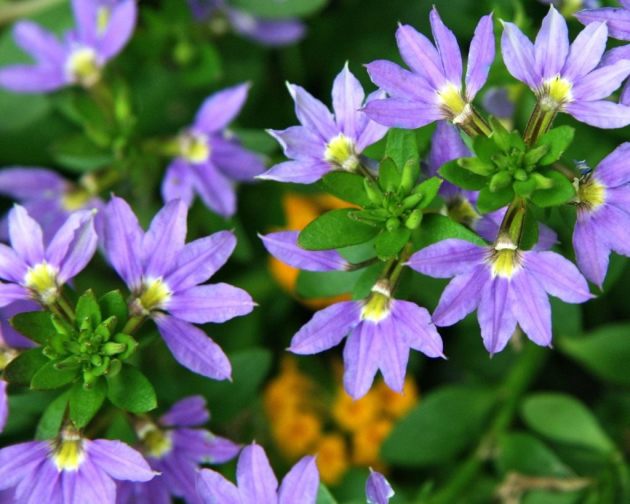
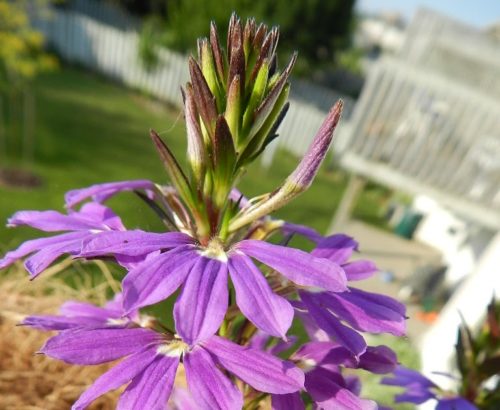
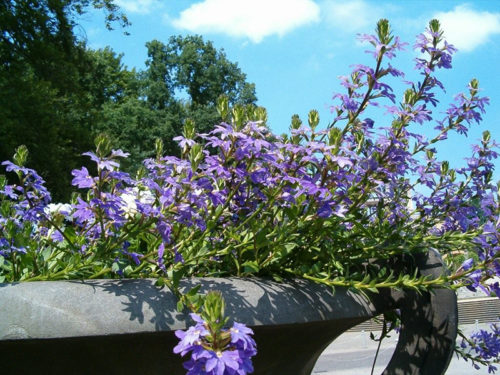
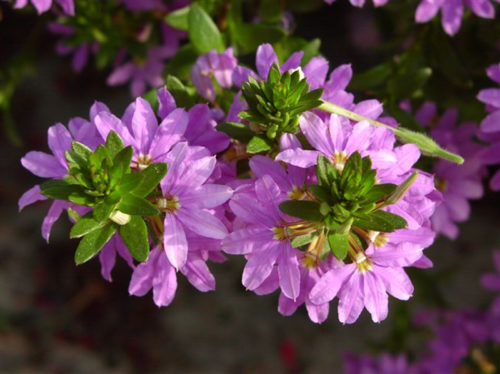
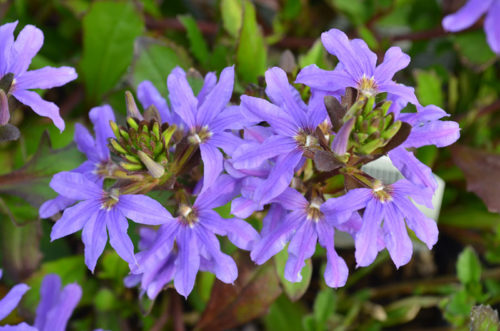
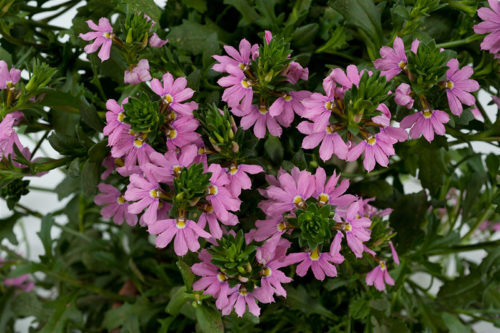
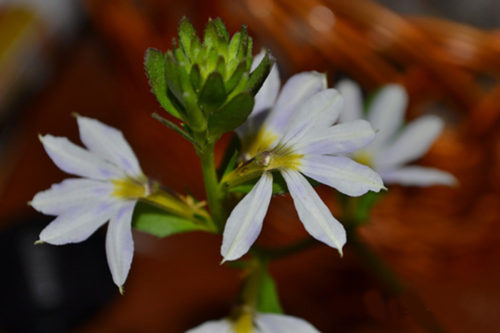
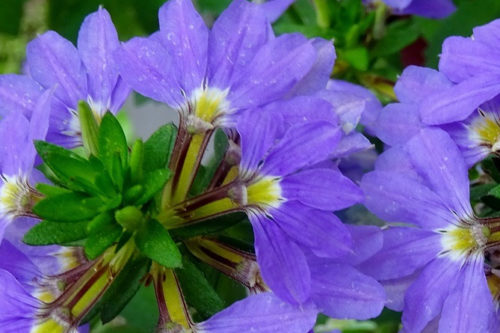
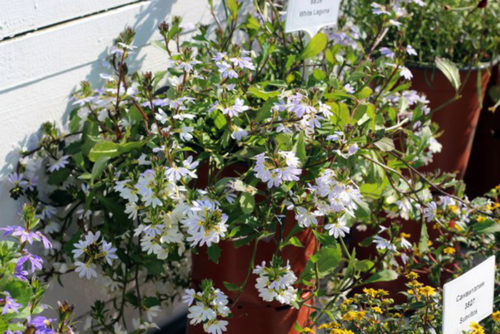
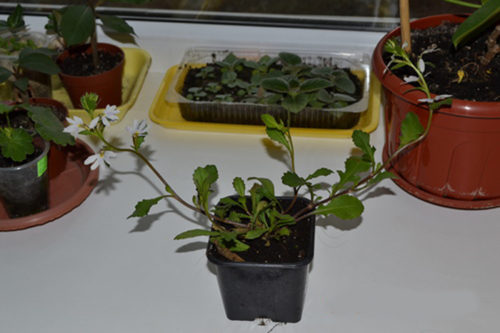
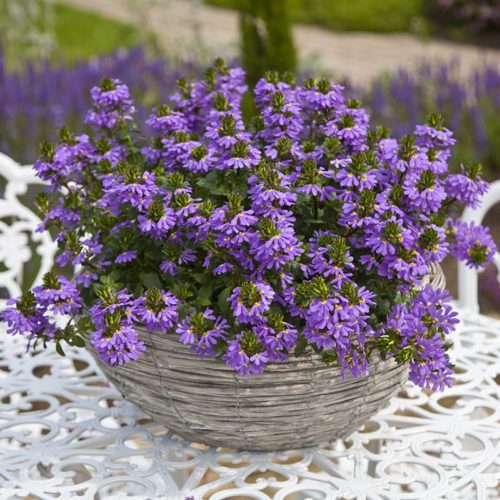
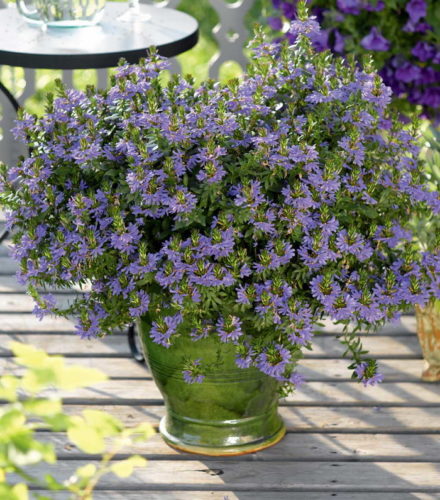

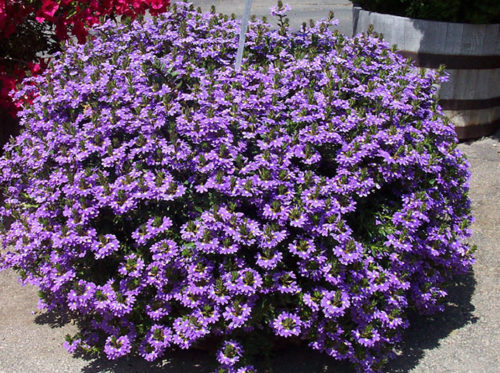
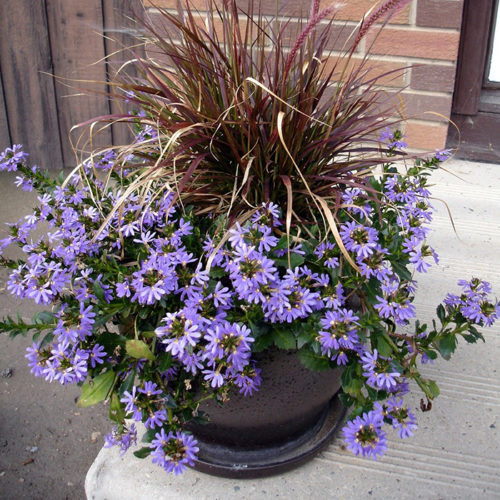
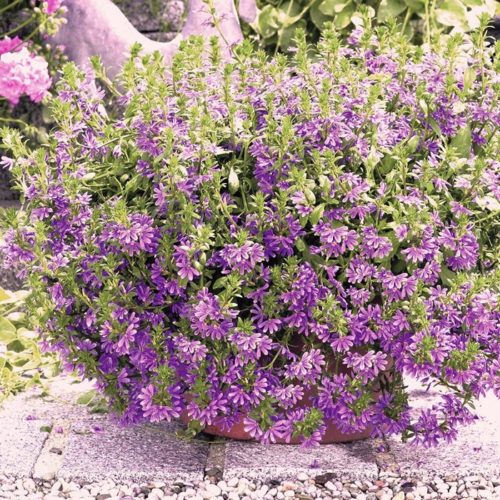












 Start a discussion ...
Start a discussion ...